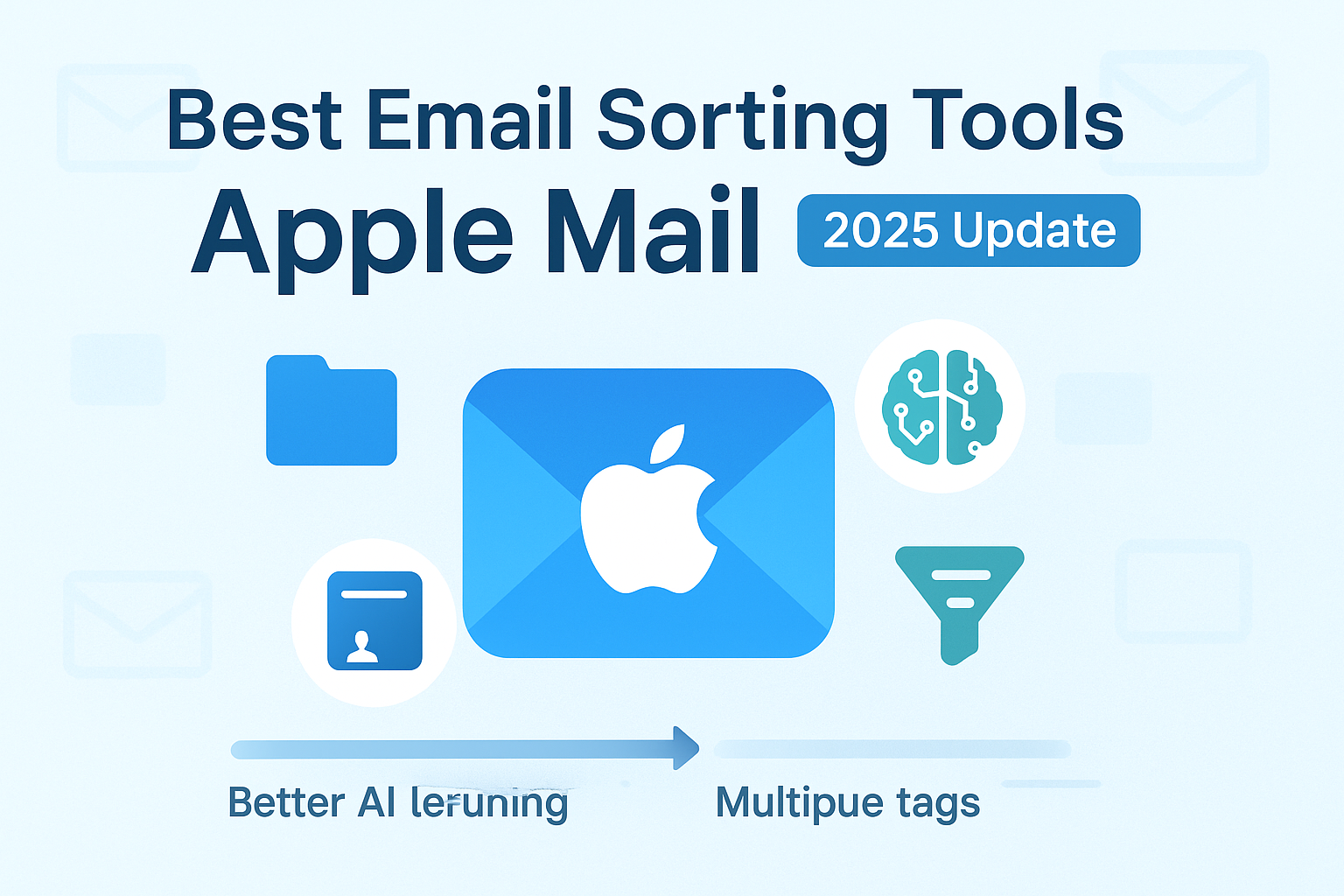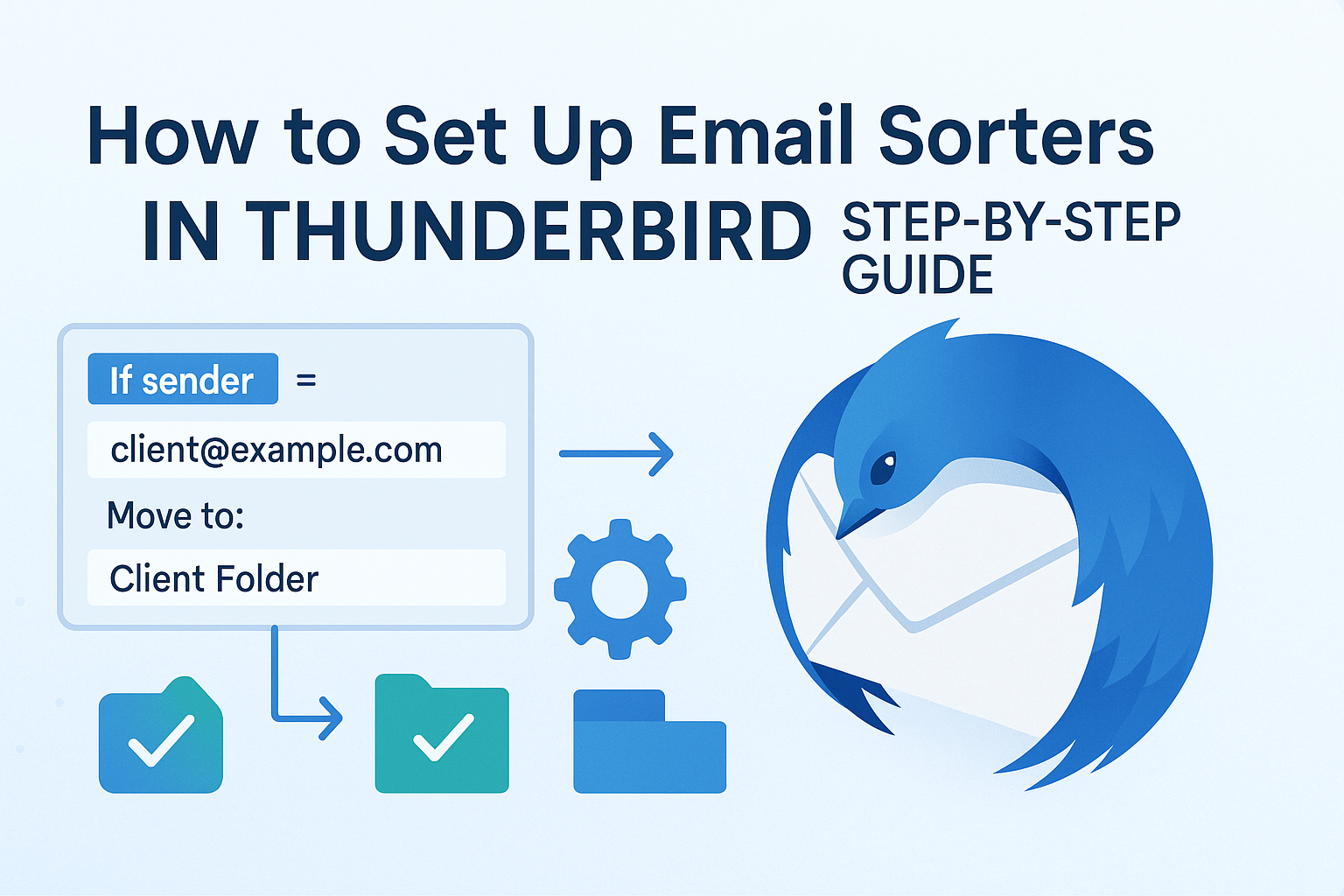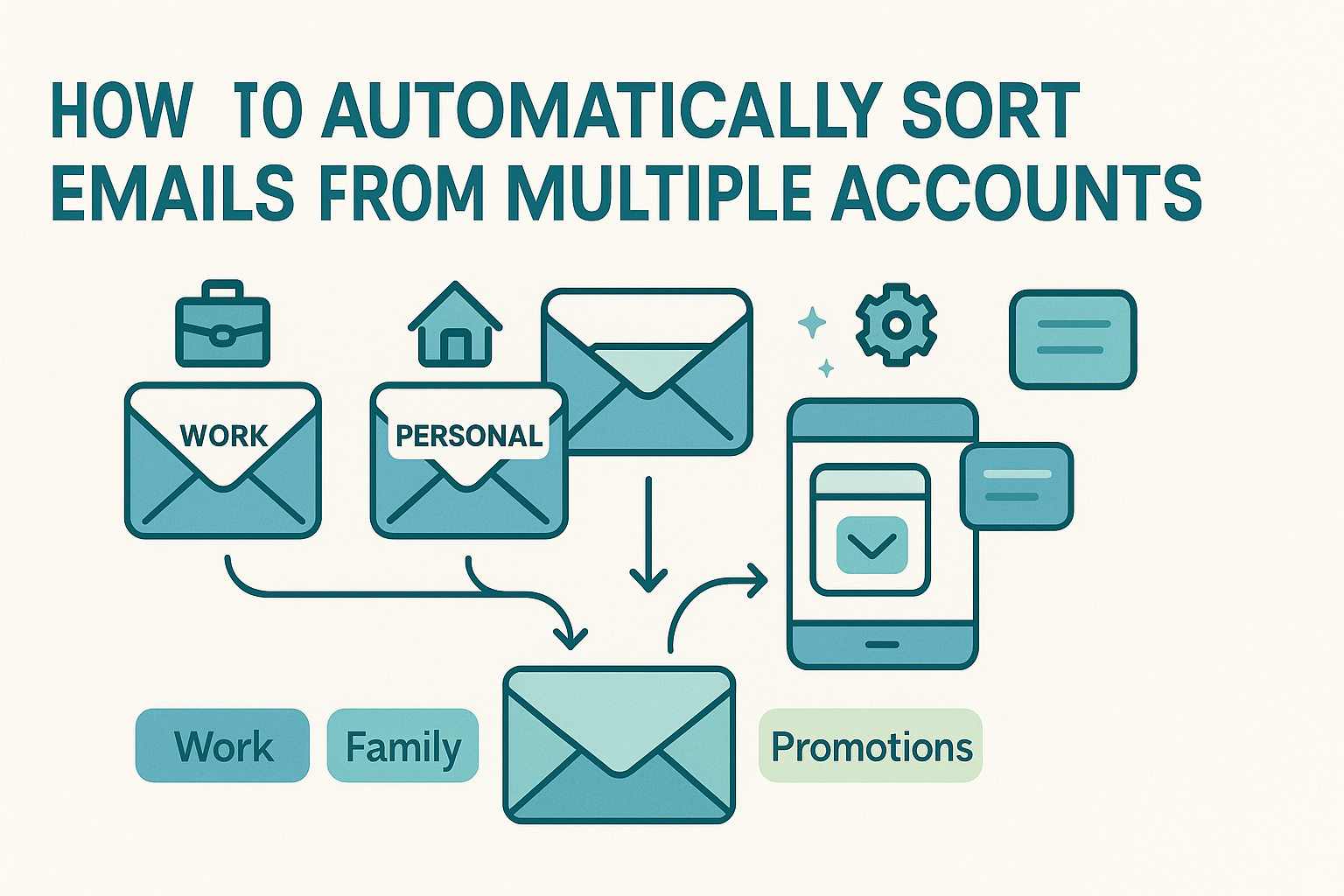Wondering how to choose the right email sorter for your team? With hundreds of messages flooding inboxes every day, the right tool can transform your workflow, saving time, reducing errors, and improving team focus.
Email sorting tools automate the way messages are organized, tagged, and routed. But not all solutions are built the same. Some are better for sales teams, others for support. Some rely on rules, while others use AI-powered sorting.
Choosing the best fit isn’t about picking the most popular or the lowest-cost option. It’s about selecting the email automation tool that aligns with your goals, tech stack, and message volume. A poor match can lead to wasted time, missed emails, and unused features.
This guide gives you a simple, practical checklist for evaluating email sorters. You’ll learn what to look for, from platform compatibility and ease of use, to integration options and AI capabilities. Whether you’re a small business owner or an IT leader, this checklist will help you make a confident, well-informed decision.
Define Your Email Sorting Goals
Before looking at features or pricing, define what problem you’re trying to solve. Email sorting tools vary widely in what they offer, so getting specific about your needs will make the rest of the process smoother and more effective.
Start with your workflow. Are you sorting customer inquiries into department-specific inboxes? Are you organizing personal messages from subscriptions, notifications, and bills? Are you trying to speed up how quickly leads reach your sales team? Each use case will demand different features. A sales-focused workflow, for example, may benefit from CRM integration and intelligent lead tagging. A support team might need tools that work well with ticketing systems.
Volume is another factor. A freelancer receiving 50 emails a day will need something different than a startup managing multiple shared inboxes with thousands of daily messages. Also consider your team size: if more than one person is interacting with the sorter, you’ll need shared rule support, admin oversight, and possibly audit logs.
Finally, consider long-term goals. Are you trying to reduce inbox management time, prevent human error, improve response times, or meet compliance requirements? Aligning the tool’s core purpose with your operational objectives makes it easier to evaluate software based on what matters most to your business.
Usability and Ease of Setup
Even the most powerful tool fails if it’s too hard to use. Usability should be one of your top priorities when choosing an email sorter. Look for intuitive interfaces that allow non-technical users to create and manage rules without needing IT intervention.
For instance, if creating a rule to tag invoices based on subject line keywords takes more than a few steps, or if every change requires admin access, the tool may not be ideal for agile teams. Time spent wrestling with the interface or interpreting poorly documented features is time that could’ve been saved with a better tool.
Good design also includes clarity. Can users see which rules are active and why a message was sorted a certain way? Is there an activity log or a visual rule editor? These elements don’t just improve functionality, they build trust and reduce resistance to adoption.
Our guide to user-friendly email sorters breaks down several top platforms ranked specifically by ease of use. If you’re part of a small team with limited time for training, or you’re setting up sorting for a busy executive, these options will be particularly valuable.
Compatibility and Platform Support
An email sorter’s capabilities won’t matter if it doesn’t run well on your preferred device or email client. Compatibility is essential, especially in environments where teams use a mix of platforms, operating systems, or email services.
Some tools work exclusively with certain clients like Gmail or Outlook, while others offer web-based platforms that integrate through APIs or browser extensions. Before you commit to any tool, make sure it supports the systems your team actually uses. It should be easy to install, configure, and run on your devices, whether that’s a Windows desktop, a MacBook, or a mobile device.
For Google Workspace users, it’s especially important to explore tools optimized for Gmail, which can harness native labels, filters, and integrations. If you’re managing multiple Gmail accounts or workspaces, see our recommendations for email sorters for Gmail to ensure maximum compatibility and speed.
Mobile usability is also key. Many users sort email while on the go, and a clunky or limited mobile interface can hinder adoption. The best email sorters make it easy to toggle rules, approve messages, or monitor sorting activity across all devices, without lag or errors.
Integration with Existing Tools
A top-performing email sorter shouldn’t function in isolation. It should connect seamlessly with the tools your business already uses. Whether that’s a customer relationship management (CRM) system, a help desk platform, or a cloud storage service, smooth integration ensures your sorting tool fits into your workflow rather than disrupting it.
For example, sales teams often benefit from sorters that can automatically tag and route inbound leads directly into a CRM like Salesforce. Without this integration, team members might have to manually forward emails, risking delays or data inconsistencies. If your operations involve this kind of complexity, it’s critical to evaluate whether the email sorter can handle third-party app syncing or at least offer API support.
There are also integrations with project management systems (like Trello, Asana, or Monday.com), allowing action items to be created from incoming messages. For customer service departments, sorting tools that link with platforms such as Zendesk or Freshdesk can route support tickets more accurately and ensure nothing falls through the cracks.
If you work in a sales-heavy environment or manage customer pipelines through a CRM, you’ll find value in reviewing our dedicated guide on Salesforce email sorting to ensure full sync between your sorting rules and lead tracking.
Integrations don’t just save time, they preserve data quality, increase consistency, and minimize duplication. Be sure your email sorter supports the specific ecosystems your team depends on.
Sorting Accuracy and Advanced Features
A basic email sorter might use static rules, such as “move all emails from this address into Folder A.” That’s useful, but many modern teams require much more nuanced behavior. Advanced features like natural language processing, machine learning, and context-aware sorting allow these tools to adapt and improve over time.
For instance, AI-driven sorters can learn from user behavior—like which emails get flagged as important—and apply that pattern across new messages. Some even recognize tone, sentiment, or urgency and sort accordingly. These systems tend to be better at handling vague or inconsistent email structures where keyword rules alone might fail.
Accuracy is more than convenience—it affects business results. If your sorter regularly misrouted urgent client emails or misses critical attachments, it could cost you time, reputation, or even revenue. That’s why it’s important to choose tools known for high precision in routing and tagging.
Performance on Different Devices
Not every team works on the latest hardware. Some organizations rely on older laptops or budget desktops, and others operate on thin clients or mobile-heavy infrastructures. In these cases, you’ll need an email sorter that’s optimized for performance—not just feature-rich, but lightweight and responsive even on modest systems.
Heavy tools with bloated UIs can cause delays, consume excess memory, or lag during batch processing. This isn’t just frustrating—it can cancel out the time savings the tool is supposed to provide. That’s why it’s worth considering resource usage, load speed, and responsiveness when evaluating your options.
For users with performance constraints or legacy hardware, we recommend exploring lightweight email sorters. These tools are engineered for minimal footprint, ensuring your team gets automation without compromising on speed or reliability.
Additionally, ensure the software doesn’t require a persistent internet connection to function. Offline-friendly functionality can make a big difference in field environments, travel scenarios, or during spotty network outages.
Pricing and Value
Cost matters, but not just the sticker price. It’s important to evaluate pricing in the context of long-term value. What you’re paying for is saved time, reduced stress, better organization, and stronger outcomes across your communication flows.
Email sorters usually come in three flavors: free, freemium, and premium. Free tools offer basic rules and filters but might lack support, analytics, or customization. Freemium platforms include more features but may lock the best ones behind a paywall. Premium services typically charge monthly or annually and provide full support, API access, and enterprise-level options.
The right choice depends on your goals. A freelancer might get by with a free version, while a growing business should consider investing in something scalable and customizable. Comparing options across these models helps avoid overpaying for unused features—or underinvesting and missing out on essential capabilities.
For a clearer picture of what each model provides, our comparison article on free vs paid email sorters helps break down where the value lies and when it makes sense to upgrade.
ROI should also be part of your pricing decision. If a tool helps your team reclaim 10 hours of email work each week, the cost quickly pays for itself. This cost-benefit balance is vital to making a sound purchasing choice.
Security, Compliance, and Privacy
When it comes to email, security isn’t optional—it’s essential. A good email sorter should protect data through encryption, secure authentication, and well-documented access control. This is particularly crucial for businesses handling customer information, financial data, or regulated communications.
Look into how each tool handles data storage. Are emails processed locally or in the cloud? If cloud-based, are the data centers secure and compliant with relevant standards like GDPR or HIPAA? How are access rights managed, and can users view logs or audit trails?
Some industries require tools that meet specific compliance benchmarks. Financial services, for example, must retain certain communications, while healthcare providers need HIPAA-compliant handling. Make sure your email sorter’s privacy posture aligns with your organization’s obligations.
To assist with vendor selection and data protection questions, consult G2’s authoritative email software selection. It offers a checklist approach to evaluating security practices and compliance compatibility for email platforms of all types.
Support, Documentation, and Community
Once your email sorter is in place, ongoing support becomes critical. Even the most user-friendly software may run into issues: integration conflicts, sorting inaccuracies, or rule misfires. When those problems arise, access to responsive, knowledgeable customer support can make the difference between a minor hiccup and a workflow breakdown.
Start by reviewing the support channels each vendor offers. Do they provide 24/7 live chat, email support, or only community forums? Is their help center searchable and well-maintained? Check whether their support staff is responsive during business hours, particularly in your region or time zone.
Documentation is another overlooked factor. Tools with clear, step-by-step instructions, video tutorials, and API references empower users to solve issues independently and train others efficiently. This is especially valuable in fast-paced or small teams without dedicated IT staff.
A strong user community is also a sign of a reliable tool. Platforms with active forums, third-party guides, or plugin ecosystems often indicate healthy user adoption and ongoing vendor commitment. If you’re troubleshooting or optimizing workflows, a vibrant community can provide helpful shortcuts or workarounds.
Reviews and Peer Feedback
Even the most polished product pages won’t show you what using a tool feels like over time. That’s why peer reviews matter. User feedback—both good and bad—gives you real-world insights into how a tool performs under pressure, how often bugs arise, and how quickly vendors respond.
Look for reviews that match your use case. If you’re a sales manager, find testimonials from similar roles. If you’re evaluating tools for a 10-person startup, ignore enterprise-only feedback that might not reflect your needs.
Pay attention to trends in the reviews. Are users consistently praising sorting accuracy or ease of setup? Are they frustrated by sync errors or limited support? These patterns are more informative than any single opinion.
A good place to begin is by exploring broader toolsets in the Google Workspace tools directory, where sorters are often listed alongside other collaboration software. This will also help you gauge how sorting tools fit into your wider digital ecosystem.
Pilot Testing and Proof of Concept
No matter how glowing the reviews, the best way to know if an email sorter works for your team is to try it. Most vendors offer free trials or low-commitment entry plans for this purpose. A pilot run allows you to evaluate key metrics in your own environment, using your actual email flow.
Set clear goals before testing: How much time do you want to save? What percentage of messages should be correctly sorted? What’s your acceptable error rate? Track these goals during the trial so you can make a data-informed decision.
Use a representative sample of your emails across departments. If the tool can accurately tag and route emails for sales, support, and admin workflows, that’s a strong indicator of fit. You should also test how easy it is to update rules, onboard new users, and integrate with existing tools.
Most importantly, gather feedback from users. A tool that frustrates your team won’t last—no matter how efficient it looks on paper. If people trust it and rely on it, the sorter will become an invisible part of your daily workflow.
Finalizing Your Decision
After pilot testing, score each contender based on your original checklist: usability, compatibility, features, support, cost, and performance. This ensures that emotional impressions or clever marketing don’t overshadow functionality.
Rank your top three options and compare side-by-side. What are the strengths and compromises? What’s the long-term value versus short-term convenience?
Be sure to check the fine print—subscription terms, data handling policies, and scalability options. A flexible pricing model that grows with your needs will always be more cost-effective than switching tools in six months.
Implementing the Chosen Sorter
Once you’ve chosen your email sorter, a smooth implementation is key. Roll it out gradually—starting with a few users or a limited department. This phased approach allows you to catch configuration issues early and gather useful feedback before full deployment.
Train your team using a combination of vendor resources and internal guidance. Be clear about how rules work, when to override them, and how to request changes. Make someone responsible for maintaining the rules as business needs evolve.
Monitor performance during the first 30 to 90 days. Are emails being sorted correctly? Are response times improving? Has inbox clutter decreased? Use these observations to fine-tune your setup.
If you want a deployment template to follow, check out the SaneBox checklist, which outlines essential implementation steps regardless of which tool you choose.
Conclusion
Choosing the right email sorter isn’t just about finding a feature-packed product—it’s about aligning a tool with how your team communicates, works, and grows. By following a structured process that includes goal-setting, testing, integration evaluation, and long-term value measurement, you dramatically increase your chances of making a choice that lasts.
From AI-enhanced filters to lightweight apps for older devices, there’s a sorting solution for every workflow and every budget. With the right match, what used to be a daily drag on productivity becomes a silent assistant—keeping your inbox clear and your team focused on what matters most.
FAQs
Q1: What’s the most important feature in an email sorter?
That depends on your workflow. For teams, integration with other tools is often critical. For individuals, ease of use and accuracy matter most.
Q2: Do all email sorters use AI?
No. Some rely on rule-based sorting only. If you want adaptive behavior, look for tools with machine learning or natural language processing features.
Q3: Are paid sorters always better than free ones?
Not always. Many free tools offer solid features, but premium versions often include analytics, support, and integrations that justify the cost. Our free vs paid email sorters article explains more.
Q4: How long does it take to implement a new email sorter?
Most tools can be deployed within a day, but full adoption and rule optimization might take a few weeks depending on team size.
Q5: Can one sorter handle both personal and team email accounts?
Yes, but choose a tool that supports multiple profiles, custom folders, and granular rules to avoid confusion.




